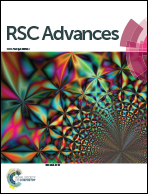An artful and simple synthetic strategy for fabricating low carbon residual porous g-C3N4 with enhanced visible-light photocatalytic properties†
Abstract
Nanoporous graphitic carbon nitrides (g-C3N4) show great photocatalytic performance owing to their unique structure. Organic templating usually was used to increase the porosity of g-C3N4, but the templating method is restricted, the technical problem is that the condensation towards larger extended CN-structures takes place around or above the decomposition temperature of the template, and thus, causes the resealing of the pores. Furthermore, the templating method usually leads to high carbon residue and lowers the photocatalytic performance. Here, the issue is addressed through the development of an artful and simple synthetic strategy to avoid the decomposition of the template at too early a stage, by taking advantage of the “two-step” heat-treated process which firstly heated in an N2 atmosphere then calcined in air. Also, the two-step strategy is easily used for obtaining low carbon residual g-C3N4 with enhanced photocatalytic activity. The obtained samples possess a higher specific surface area (126 m2 g−1) and more abundant pores, and a band gap increase of 0.08 eV in comparison with bulk g-C3N4. The photocatalytic activity of the samples was evaluated by oxidative dehydrogenation of 2-propanol to acetone under visible light illumination. The enhanced performance was mainly ascribed to the high specific surface area, which contains more active sites for reaction. This artful and simple strategy can in general be expanded to the organic templating method for preparing porous g-C3N4, enabling the creation of stable polymeric CN nanostructures with maximized material and structure functions.


 Please wait while we load your content...
Please wait while we load your content...